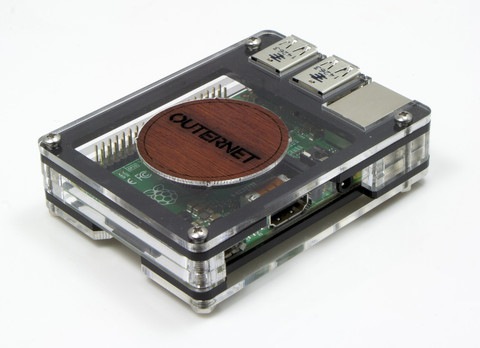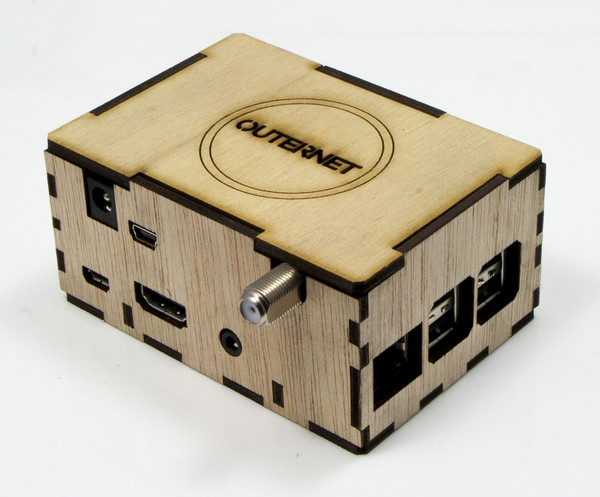Topic: COMMUNITY INTEREST


There are inflection points that change the course of humanity. Access to the internet is an example of one such event. A new device, called the LANTERN, manufactured by a NY- based company, Outernet, has the potential to change the world. Their device has the ability to continuously receive radio waves broadcasted by outernets in space and turn them into digital files. When you want to get onto the internet, one would just turn on your device and enable your wifi enabled device. It is that easy. It works like an offline version of the internet that updates constantly.
Outernet takes the best of the web and broadcasts it from space for every human on Earth. The content that they broadcast is determined by anyone who chooses to vote on the most important things to share with humanity. Outernet repurposes broadcast satellite TV equipment and we offer instructions on how to build a DIY-receiver. Once a receiver is configured, Outernet’s content can be accessed by any WiFi-enabled device.

This new device, the Lantern, will allow us to response faster and more efficiently during the next natural or man made disaster. When cell towers go down and cell towers are compromised, you will not longer be compromised. You will be able to get your news anywhere in the world, even the countries with strong censorship rules. You will never have a huge cell phone bill again during your oversea travels, use your Lantern.
The world will be able to create their own digital library. Parents can control what their kids see. The Outernet will have courses available to build literacy in parts of the world where literacy is compromised. This makes education and learning truly universal.
Outernet is working with IREX in Namibia and the World Bank in Sudan to turn on Lanterns in those countries. This is just the beginning. Lantern is broadcasting from space, so if you have a government that says you can’t watch this or see that, Lantern lights the path to override this censorship. Everything a user consumes is anonymous.
Everyone on Earth can use the Lantern. You will be able to use the Lantern to download news, weather, books, videos and audio for FREE. You will have access to information, freedom from censorship and consume Internet content anonymously. You will even be able to charge your phone with Lantern.
There are projects with similar goals, like Project Loon from Google and Internet.org from Facebook. These are very different from Outernet’s Lantern. Both of these alternatives will only provide two-way Internet to everyone. That is a commendable goal, but it will also be a fee-based service. Facebook’s (internet.org) is a partnership between social networking service company FACEBOOK and six mobile phone companies: Samsung, Ericsson, MediaTek, Nokia, Opera Software, and Qualcomm) that aims to bring affordable Internet access to everybody by increasing affordability, increasing efficiency, and facilitating the development of new business models around the provision of Internet access.
Google’s Project Loon is a research and development project. Its mission is to provide Internet access to rural and remote areas. The project uses high-altitude balloons placed in the stratosphere at an altitude of about 32 km to create an aerial wireless network with up to3G-like speeds. The balloons are maneuvered by adjusting their altitude to float to a wind layer after identifying the wind layer with the desired speed and direction using wind data from the National Oceanic and Atmospheric Administration. Users of the service connect to the balloon network using a special Internet antenna attached to their building. The signal travels through the balloon network from balloon to balloon, then to a ground-based station connected to an Internet service provider, then onto the global Internet. This balloon project I suspect will deflate quickly, although a cool concept.
Outernet's signal is free to receive. There are no balloons or slick corporate maneuvers involved. There are also sovereign air space issues with Internet devices, like balloons and drones, inside the atmosphere. Breaking censorship will be difficult in places where a free Internet is unwanted this these approaches. You also encounter enormous spectrum regulation when the user device goes from being a receiver to a transmitter (it talks back). So you can see they are not competing services, as we are solving a problem for a different segment of the market.
Outernet is directly hooking into the satellite operator’s infrastructure. Their uplink bandwidth is really not measured. Their download speeds, however, range from 100 kbps to 25 Mbps. Technically, they are able to burst to download speeds of 80 Mbps, but they prefer to make content available to small-sized antenna, so we will likely limit download speeds to 25 Mbps. A 25 Mbps downlink can deliver 10 GB of data over the course of an hour.
Is this a new era, no censorship? Outernet works so that if one frequency is jammed, they simply move to an alternative--and can do this across 5 difference channels (or more). Since Outernet is a broadcast solution, the monitoring stations are actually irrelevant, since the reception of broadcast content ensures the anonymity of consumption. Since they use existing spectrum licenses, their anti-censorship plan is all perfectly legal and abides by all restrictions of local jurisdictions. But since they are broadcasting data in a multi-channel, multi-speed, and super duplicated manner, it just makes it hard to selectively censor specific works that we distribute. Of course, a government is always able to continuously jam all of our frequencies (this is a little more difficult for certain bands), but which government wants to be the one that is publicly known for disrupting humanity's public library?
Outernet currently resides on two satellites, Galaxy 19 and the Hotbird in space. This covers NE, Europe, the Middle East and North Africa. Outernet plans on broadcasting from 5 additional satellites in the near future. They will be able to broadcast to the entire world, for free once this implementation takes effect.
Outernet takes the best of the web and broadcasts it from space for every human on Earth. The content they broadcast is determined by anyone who chooses to vote on the most important things to share with humanity. Outernet repurposes broadcast satellite tv equipment and they offer instructions on how to build a DIY-receiver. Once a receiver is configured, Outernet’s content can be accessed by any WiFi-enabled device.



 Photo: Tassaneewan Laksanasopin
Photo: Tassaneewan Laksanasopin





 Photo: McLaren Applied Technologies
Photo: McLaren Applied Technologies
